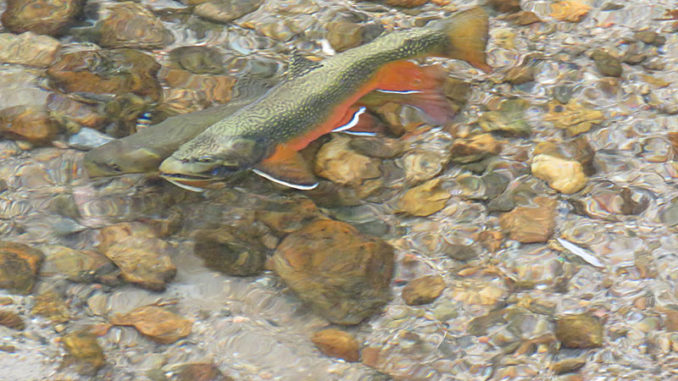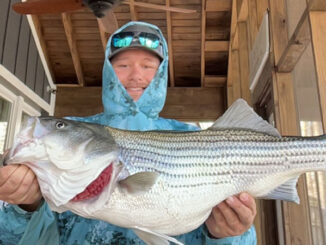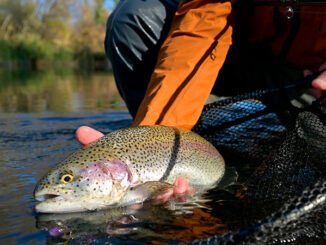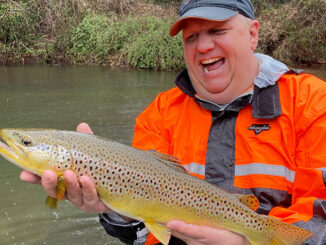
It only stands to reason that spending more time on sub-surface fishing will allow the presentation of the fly to more fish. Nymph fishing is statistically more successful.
By learning to fish successfully with nymphs, you have a much greater opportunity mathematically. It is true that certain selections will yield more fish on a given day. But if you learn to fish nymphs properly, you’ll greatly increase both numbers and quality of fish taken.
Generally speaking, leader length is not that critical when nymph fishing. A 7 1/2-foot leader is adequate. Many newcomers to nymphing are drawn to using indicators. I am not a fan of inidicators, preferring to watch the juncture where the leader enters the water.
Any twitch should result in the angler setting the hook. It is much better to try setting the hook when the fly merely bumped a rock, than not setting the hook when a fish strikes.
You may feel silly setting the hook when nothing is there, but you’ll also be surprised when a subtle twich is actually a trout picking up the nymph.
The only time I feel that an indicator is an advantage is when fishing “big” water. That means a lot of line is on the water, and the indicator helps to detect long-distance strikes.
Subsurface trout are usually hugging the bottom, so choosing the proper weight is essential. The swifter the water is, the more weight is required to get the fly down to a successful level.
The use of weight may be achieved in two manners. One way is to clip a splitshot onto the leader a few inches above the nymph. The other, which I prefer, is to tie the nymph with tungsten beadheads.
With experience, you will learn that certain spots will hold more trout. If you have been a dry fly fisherman, you already recognize many of them. Fighting the current is tiring for fish, so they choose areas such as rocks in the stream or dips in the bottom contour that feature less current. From these spots, trout can easily move out to catch an insect, then drop back into the slack current.
As you learn to recognize these spots, your success rate will soar. Don’t spend your time on non-productive water. Instead, use it wisely by fishing the best locations.
The basic setup would be one nymph on the end of the leader or tippet and a split shot a few inches above it. If your numph is tied with a tungsten beadhead, the shot is not necessary. If you choose, you can use multiple flies, as long as local regulations permit it.
If you choose to use two flies, use a bigger fly in front and a smaller fly lower. Tie the first fly onto the end of the leader. Then, use tippet to tie onto the bend of the larger fly and to the eye of the hook of the second fly. This will track better than tying the tippet into the eye of the first hook.
Regarding knot preference, we still use the improved clinch knot. Numerous other knots are also good choices. As long as they do not slip, they will suffice.
A recent setup was discussed online where multiple flies were tied onto the leader/tippet and a short section of tippet was tied onto the bend of the last hook.
A simple overhand knot was tied in the terminal end of the tippet and one to several split shot pinched onto the tippet. This rig would allow the weight to bounce along the bottom of deeper water and not be as susceptible to hanging up on rocks or debris. This one is definitely on my list to try.
Final thoughts
As in dry fly fishing, achieving a realistic, dead drift is critical. If your leader or strike indicator is creating a “V” wake in the water, you are not likely to catch fish.
If you are stealthy, long casts are not necessary. In order to extend your drifts, cast upstream or quartering upstream, and as the nymph drifts closer to you, lift the rod tip to take up slack in the fly line. As it passes your position, lower the rod tip to extend the drift downstream.
By using the correct technique, you may extend your drift significantly.
You can’t catch trout with the fly in the air, so keep it in the water and set the hook. Good luck as you concentrate on nymphing.
Numerous delayed harvest streams are now open to anglers, and it is a great time to take advantage of these streams. To paraphrase Lee Wulff, “A trout is too valuable a resource to only be caught once.”




Be the first to comment